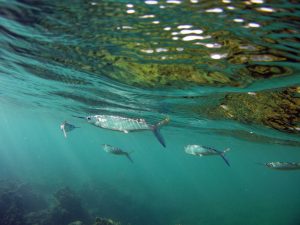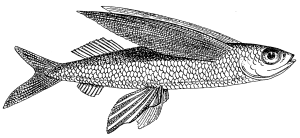NAVIGATION:
This page is posted on a blog/website “Barbados Fringing Reefs & Seagrass Beds”
URL: www.versicolor.ca/barbados.
This page is a subpage of www.versicolor.ca/barbados/lit-links/fish/
The URL for this page is: www.versicolor.ca/barbados/lit-links/fish/garfish-in-barbados/
There are two subpages for this page:
– Search “Gar Fish” or Garfish + Barbados on Social Media
– “Long Fish” (gar) pics
My curiosity about these fish began with a question about “houndfish”
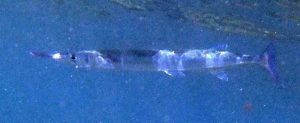
Observed Mar 5, 2025 near Reef Crest, in Barbados MPA. View iNaturalist record. iNaturalist member sue1001 disagreed with my ID of it as a redfin needlefish (Strongylura notata), commenting “[it’s a]” Houndfish Tylosurus crocodilus – [note] Shorter, thicker beak. No red/yellow fins. Nice find!”
Now I’m not so sure, only that it is a needlefish – or what Bajans call “gar” or “garfish”.
Click on images for larger versions
I was curious as to how common houndfish might be in Barbados. I could find no references to “Houndfish, Barbados” on social media, so I sent this message to spearfishingbarbados.com on Aug 31, 2025:
I visit BIM in the early winter months, ‘do a lot of snorkelling and underwater photography, especially in the MPA on the west coast. I finally got a reasonably good photo of larger fish I kept seeing but hard to get close to, and via iNaturalist, identified it as a houndfish. I have searched for mention of houndfish in Barbados but have found none… can you tell me, are you familiar with this fish in Barbados?
https://www.inaturalist.org/observations/309681163 Thx for any comment.
Alex Davis of Spearfishing Barbados replied,
“So yes it certainly looks like a houndfish, I have caught many of them in the Bahamas with rod and reel off the beach. I do see them occasionally here in Barbados but they like to keep their distance so it’s hard to get up close with them…Here’s a photo of a houndfish caught (and released) spin fishing in the Bahamas back in 2017 – they do put up a good fight!”
Gar is a common name in Barbados for “houndfish”
I looked further for “Houndfish, Barbados” in scientific and social media… ‘eventually found one reference to a “hound” fish, that on FishBase:All fishes reported from Barbados; it attributes a record for ” Hound (Tylosurus crocodilus) ” to “Butsch, R.S., 1939. A list of Barbadian fishes. J.B.M.H.S. 7(1):17-31.” On the FishBase page, “Gar” is cited as a local English name for Houndfish.
Searches for “gar fish, Barbados” or “garfish, Barbados” bring up many references to such fish in Barbados on social media but few pics or it’s not clear from the pics whether or not they are houndfish. View Some Examples.
This FAO document cites “garfish” as a targeted species of the coastal pelagic fishery in Barbados:
FAO FISHERY COUNTRY PROFILE: Barbados (https://www.fao.org/fishery/docs/DOCUMENT/fcp/en/FI_CP_BB_old.pdf)
“Jacks (Carangidae), herrings (Clupeidae), silversides (Atherinidae), anchovies (Engraulidae), ballyhoo (Hemiramphus spp.), robins or scads (Decapterus spp.), barracuda (Sphynaena spp.), garfish and small tunas are the targeted species of the coastal pelagic fishery. These species are used mainly as bait for other fisheries, although some may be used as food. The resource status of this fishery has not been assessed. Annual estimated catches of jacks and small tunas during the period 1994-2003 ranged from approximately 8 to 33 tonnes”
From a fisheries expert: the terms “gar” and “garfish” in Barbados refer to needlefishes,
Finally, I connected with with Dr. Julian Walcott, lecturer at UWI-CERMES, who teaches Fisheries Biology and Management. In response to my asking if he could “comment on “garfish” in Barbados… are these refs to houndfish, is houndfish a common catch?”, Dr Walcott told me:
Locally we call these needlefishes ‘Gar’ fish. It is hard to exactly tell from the image provided, but it could either be the Keeltail needlefish (Platybelone argalus), the Flat needlefish (Ablennes hians) or the Houndfish (Tylosurus crocodilus). These are quite common in our waters, often observed by swimmers and snorkelers right below the surface.
To my knowledge, it is not a target species of most fishers. The Ballyhoo (Hemiramphus brasiliensis) and Baloa (Hemiramphus balao), however are…. I hope this helps.
Indeed it does! Below are pics and abbreviated descriptions of the species cited by Julian Walcott.
– Keeltail needlefish (Platybelone argalus)

Keeltail needlefish (Platybelone argalus). From Wikipedia: Keeltail needlefish
From Wikipedia: Keeltail needlefish:
‘The keeltail needlefish (Platybelone argalus), sometimes called the keeled needlefish, is a tropical fish of the family Belonidae…Keeltail needlefish, like all needlefish, closely resemble North American freshwater gars (family Lepisosteidae). It is most recognized by the large, flat keel-like structures running on either side of the tail… grow up to 50 cm long. The keeltail needlefish’s top jaw is also smaller than the lower one… They usually occur offshore and are abundant around islands.They school in sheltered parts of reefs, feeding mainly on smaller fish.”
– Flat needlefish (Ablennes hians)
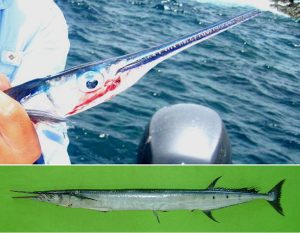
Flat needlefish (Ablennes hians). From Wikipedia: Flat Needlefish
From Wikipedia: Flat Needlefish:
“The flat needlefish (Ablennes hians), or barred longtom, the only known member of the genus Ablennes, is a marine fish of the family Belonidae. Flat needlefish are considered gamefish, frequently caught with the help of artificial lights, but are not often eaten because of their green-colored flesh…Dorsally, flat needlefish are blueish, white ventrally, with dark blotches and 12-14 vertical bars in the middle of their bodies. Flat needlefish have elongated bodies, with scythe-shaped pectoral and anal fins. They also have a dark lobe on the posterior part of their dorsal fins…The longest recorded flat needlefish measured 140 cm…Flat needlefish are found worldwide in tropical and temperate seas…Flat needlefish usually live in neritic ocean waters near islands, estuaries, and near coastal rivers, where they feed on smaller fishand occasionally gather in large schools.”
– Houndfish (Tylosurus crocodilus).
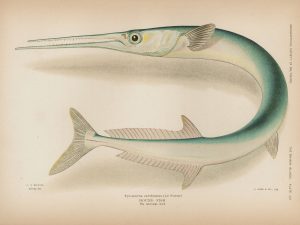
llustration from The Bahama Islands by The Geographical Society of Baltimore 1905.From Wikipedia: Houndfish
From Wikipedia: Houndfish:
“The houndfish, or more specifically the crocodile needlefish (Tylosurus crocodilus) is a game fish of the family Belonidae, the needlefishes. It is the largest member of its family, growing up to 5 feet (1.5 m) in length and 10 pounds (4.5 kg) in weight…A key way of distinguishing the houndfish from other members of the genus Tylosurus is that the houndfish’s teeth point anteriorly when the fish is a juvenile. The teeth of other species are straight at all ages. The houndfish also has a more stout, cylindrical body and a shorter head than other needlefishes. Juvenile houndfish possess an elevated, black lobe on the posterior of their dorsal fins.”
From Wikipedia: Tylosurus:
“Tylosurus is a genus of needlefish, one of ten in the family Belonidae. They are found worldwide in tropical and warmer temperate seas[2] and two species have been recorded as Lessepsian migrants in the eastern Mediterranean Sea.”
Halfbeaks (ballyhoo and baloa) are often caught with “gar” (needlefishes)
The final two species mentioned by Julian Walcott, ballyhoo and baloa, are not commonly referred to as gar or garfish, but have similar habits and are often caught along with gar (e.g., see This Video – Oisten Jetty by Night – at 10:38ff). Like the species above, they have long beaks but bodies are thicker and the fish smaller and I think are not readily confused with “gar”. They belong to a family of fish commonly known as “Halfbeaks” so named “for their distinctive jaws, in which the lower jaws are significantly longer than the upper jaws” (Source: Wikipedia: Halfbeak). As it turns out their resemblance to needlefish has some genetic basis, the halfbeaks belonging to a lineage that is ancestral to needlesfishes; flying fish are even further up in that lineage.
– Ballyhoo (Hemiramphus brasiliensis)
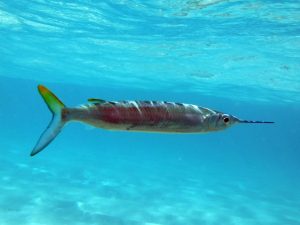
Ballyhoo (Hemiramphus brasiliensis ) in Cuban waters. From Wikipedia: Ballyhoo
From Wikipedia: Ballyhoo
The ballyhoo halfbeak, ballyhoo, balahu, redtailed balao or yellowtail ballyhoo (Hemiramphus brasiliensis) is a baitfish of the halfbeak family (Hemiramphidae). It is similar to the Balao halfbeak (H. balao) in most features. Some are used for trolling by saltwater anglers…The body shows typical halfbeak shape with an elongated lower jaw and cylindrical elongated body…The longest recorded Jumping halfbeak was 55 cm long, but most do not exceed 35 cm…In Florida, they inhabit shallow bank areas or grassflats associated with coral reefs.
I am quite familiar with this species which can be seen most days over “the wreck” and adjacent areas of the fringing reef at Vauxhall, Barbados. A feature distinguishing it from Balao, according to my GoTo Coral and Fish Guide,* is the orange coloration of the upper tail lobe.
* Daz & Jerry Greenberg, Guide to Corals and Fishes of Florida, the Bahamas and the Caribbean (Seahawk Press, 1977).
– Baloa (Hemiramphus balao)

Balao halfbeak ((Hemiramphus balao)) From Wikipedia: Balao halfbeak
From Wikipedia: Balao halfbeak:
“The balao halfbeak (Hemiramphus balao), occasionally called the balao for short, is an ocean-going species of fish in the family Hemiramphidae… They are used as cut bait and for trolling purposes by saltwater sportsmen…The balao halfbeak is similar in appearance to its relative the ballyhoo (H. brasiliensis). The main difference between the two is that the distance from the nares to the base of the pectoral fin is greater than the length of the ballyhoo’s pectoral fin, while that difference is less than the length of the balao halfbeak’s pectoral fin… Balao halfbeaks have blue-gray skin on their backs,[4] while their undersides are silver or white. The longest recorded balao halfbeak was 40 cm long…Balao halfbeaks can form fairly large schools, in which they feed on smaller fishes and zooplankton.They can be found in both brackish and marine waters and are associated with reefs.”
More about the terms “gar” and “garfish”
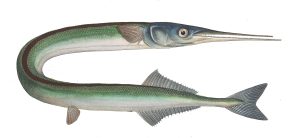
1795-1797 illustration. From Wikipedia: Garfish (Belone belone),
From Wikipedia: Needlefish
“Needlefish (family Belonidae) or long toms are piscivorous fishes primarily associated with very shallow marine habitats or the surface of the open sea. Some genera include species found in marine, brackish, and freshwater environments (e.g., Strongylura), while a few genera are confined to freshwater rivers and streams, including Belonion, Potamorrhaphis, and Xenentodon. Needlefish closely resemble North American freshwater gars (family Lepisosteidae) in being elongated and having long, narrow jaws filled with sharp teeth, and some species of needlefishes are referred to as gars or garfish despite being only distantly related to the true gars. In fact, the name “garfish” was originally used for the needlefish Belone belone in Europe and only later applied to the North American fishes by European settlers during the 18th century.”
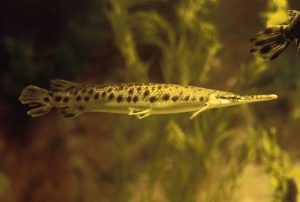
Spotted gar
(Lepisosteus oculatus)From Wikipedia: Gar
From Wikipedia: Gar:
“Gars are an ancient group of ray-finned fish in the family Lepisosteidae. They comprise seven living species of fish in two genera that inhabit fresh, brackish, and occasionally marine waters of eastern North America, Central America and Cuba in the Caribbean…Gars have elongated bodies that are heavily armored with ganoid scales,[4] and fronted by similarly elongated jaws filled with long, sharp teeth. Gars are sometimes referred to as “garpike”, but are not closely related to pike, which are in the fish family Esocidae. All of the gars are relatively large fish, but the alligator gar (Atractosteus spatula) is the largest; the alligator gar often grows to a length over 2 m (6.5 ft)…
“The name “gar” was originally used for a species of needlefish (Belone belone) found in the North Atlantic and likely took its name from the Old English word for “spear”. Belone belone is now more commonly referred to as the “garfish” or “gar fish” to avoid confusion with the North American gars of the family Lepisosteidae.
“Confusingly, the name “garfish” is also commonly used for a number of other species of the related genera Strongylura, Tylosurus, and Xenentodon of the family Belonidae.”
On the genetic relatedness of needlefish, halfbeaks, flying fish (Order Belonformes)… and freshwater gar (Order Lepisosteiformes)
Molecular Biology and Taxonomy sciences tell us that needlefish (commonly called “gar” or “garfish” in Barbados, halfbeaks (ballyhoo and baloa) and flying fish belong to a common genetic lineage (Order Beloniformes) which is relatively young in evolutionary terms (circa 50 million years), and are only very distantly related to the somewhat look-alike freshwater gars and allies (Order Lepisosteiformes) which took shape circa 400 million years ago.
– Reinterpreting recapitulation: systematics of needlefishes and their allies (Tteleostei: Beloniformes)
Nathan R. Lovejoy, 2007. In Evolution. Full text “Abstract. As needlefishes (Belonidae) grow, their jaws pass through a ‘‘halfbeak’’ stage that resembles the adult jaw condition of the closely related family of halfbeaks (Hemiramphidae). Based on this pattern, some authors have suggested that halfbeaks are ‘‘developmentally arrested’’ or paedomorphic needlefish derivatives, whereas others have supported the notion that needlefishes are descended from halfbeak-like ancestors and that needlefish ontogeny thereby recapitulates phylogeny. To test these ideas and to better understand evolutionary changes in jaw ontogeny, phylogenetic relationships among genera of needlefishes, sauries (Scomberesocidae), halfbeaks, and flyingfishes (Exocoetidae) were assessed using mitochondrial (cytochrome b and 16S), nuclear (Tmo-4C4), and morphological characters. The resultant tree provides several novel taxonomic findings: (1) flyingfishes appear to be nested within halfbeaks; (2) sauries appear to be nested within needlefishes; and (3) the Indo-West Pacific freshwater halfbeaks appear to be most closely related to the needlefish/saury clade. The structure of the tree falsifies the idea that halfbeaks are paedomorphic needlefishes. Instead, halfbeaks are basal relative to needlefishes, fitting the pattern predicted by the hypothesis of recapitulation. I discuss limitations to phylogenetic perspectives on recapitulation based on discrete character data by comparing aspects of von Baerian and Haeckelian views of the relation between ontogeny and phylogeny.

” FIG. 2. Consensus of two most parsimonious trees produced by unweighted analysis of all data (total evidence hypothesis)…”. [Diagram illustrating the evolutionary lineage of needlefish and their allies]
(FishBase)
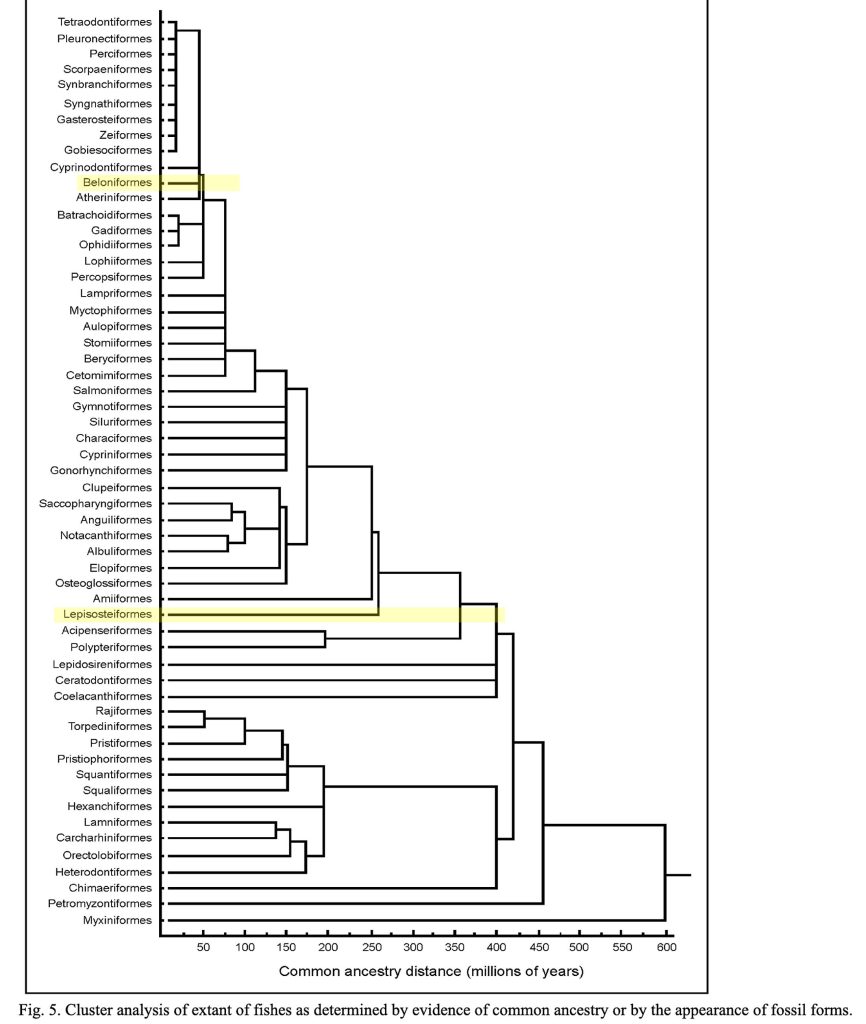
Note that needlefish are in the Order Belonformes (near the top of diagram), Freshwater and fossil gar are in the Order Lepisosteiformes, a much older Order.
Conclusion
 The common names gar and garfish have been and are still, variously, applied to sometimes very large fish with long beaks (long snouts, elongated jaws) and needlelike teeth in the families Lepisosteidae, and Belonidae; the resemblance is not genetic as these families are only very distantly related. A visitor from Canada, Jim Chambers, who spotted a dead needlefish on the beach in Barbados commented “Took photo of this fish, on the beach at Hastings, not far from the garrison. In Canada these are called Gar Fish, are they the same thing in Barbados?”
The common names gar and garfish have been and are still, variously, applied to sometimes very large fish with long beaks (long snouts, elongated jaws) and needlelike teeth in the families Lepisosteidae, and Belonidae; the resemblance is not genetic as these families are only very distantly related. A visitor from Canada, Jim Chambers, who spotted a dead needlefish on the beach in Barbados commented “Took photo of this fish, on the beach at Hastings, not far from the garrison. In Canada these are called Gar Fish, are they the same thing in Barbados?”
My understanding now is that Bajans apply “gar” or “garfish” only to needlefish (family Belonidae); these cannot be said to be closely related to the Gar Fish of Canada – at least the connection is no more than the relationship of humans to whales, for example. Those gar fish belong to an ancient order of mostly freshwater fish with heavily armored bodies and elongated jars with sharp teeth; the alligator gar (Atractosteus spatula) is the largest (6.5 feet) (the Houndfish (Tylosurus crocodilus) occurring in Barbados is up to 5 feet).
Three species of needlefish commonly occur in Barbados: keeltail needlefish (Platybelone argalus), flat needlefish (Ablennes hians) and houndfish (Tylosurus crocodilus). Related somewhat closely genetically and also commonly seen near the sea surface in Barbados are halfbeaks (including Ballyhoo and Belao with shorter beaks than needlesfish) and the famously Bajan flying fish (without beaks).
Now, looking more critically at my better photos of “the long fish” I have frequently observed near the reef crest of fringing reefs in the Barbados MPA, I agree with the uncertainty about the ID expressed by Julian Walcott above; I don’t think I can say whether they are houndfish or flat needlefish. They are too large (3 to 4+ feet by my estimate) to be the keeltail needlefish which according to the description above are maximally about 50 cm or 1.6 feet; * houndfish grow to 5 feet and flat needlefish to 140 cm/4.6 feet, so my sightings could be of either species or perhaps both. Based on the descriptions, it seems I would probably need to view landed specimens close-up and perhaps at different life stages to say for sure which species are involved.
*I am Canadian and we are metric but I grew up in pre-metric days and still estimate sizes in feet and inches).
One bit of info. I learned that will make me a bit wary of needlefish in future:
Needlefish, like all ray-finned beloniforms, are capable of making short jumps out of the water at up to 60 km/h (37 mph). Since needlefish swim near the surface, they often leap over the decks of shallow boats rather than going around. This jumping activity is greatly excited by artificial light at night; night fisherman and divers in areas across the Pacific Ocean have been “attacked” by schools of suddenly excited needlefish diving across the water towards the light source at high speed. Their sharp beaks are capable of inflicting deep puncture wounds, often breaking off inside the victim in the process… Occasional deaths and serious injuries have been attributed to needlefish. – From en.wikipedia.org/wiki/Needlefish
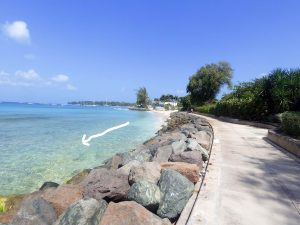 One day this past February I was snorkelling in the shallows by Reef 33 in the MPA, when a large fish crashed into the water beside me; thinking it must have been a large tarpon, I immediately left the area. Now I wonder if it was a needlefish, and whether I had narrowly escaped getting stabbled in the back!
One day this past February I was snorkelling in the shallows by Reef 33 in the MPA, when a large fish crashed into the water beside me; thinking it must have been a large tarpon, I immediately left the area. Now I wonder if it was a needlefish, and whether I had narrowly escaped getting stabbled in the back!
‘Can’t wait to get back there and, cautiously, to get some better pics of these gar/gar fish/needlefish. I will also talk to fishers at Surfside and perhaps view some fish really close-up to determine finally whether what I have been seeing are houndfish or flat needlefish. I understand they are good eating as well!
– david p Oct 4, 2025
More Links
Online Guide to the Animals of Trinidad & Tobago (OGATT): OGATT Fish
– Tylosurus crocodilus (Stickfish or Houndfish)
Charnele Quamina Posted online: 2016– Strongylura marina (Atlantic Needlefish)
Cheyenne Ramesar Posted online: 2015– Ablennes hians (Flat Needlefish)
Author: Jolene Mendez Posted online: 2015
Folkstone MPA iNat Species
Page on this website.

